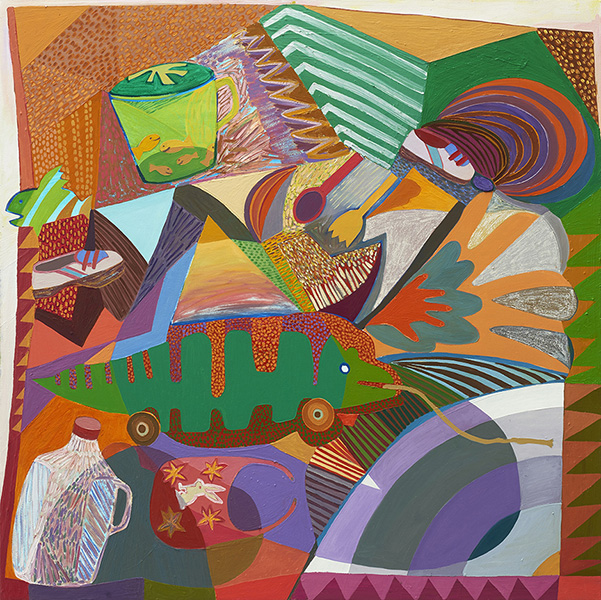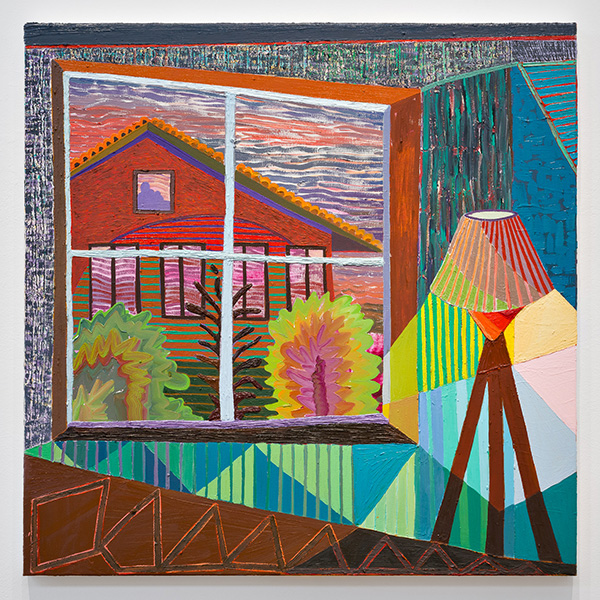
March 15, 2018
Karla Wozniak @ Gregory Lind
by Barbara Morris
Recent studies dispute the assumption that men are better navigators than women, with spatial orientation skills inherently superior as demonstrated by various tests. When the parameters of the tests are slightly shifted, as done by researchers at UC Santa Barbara, the disparity in performance based on gender disappears. This stereotyping relates to the roles of men and women in primitive societies: namely, that men, as hunters and gatherers, develop sharper navigational skills, while women, devoted to domestic chores, lag behind. The debate over test results, whether influenced by nature or nurture, or by prejudicial testing bias, will no doubt continue.
Living Room Days, Karla Wozniak's current show at Gregory Lind, is on one level an investigation of these lingering traits. The artist, having recently given birth, appears to have traded a vigorous exterior focus for something more domestic. Yet Wozniak turns the situation inside out. Her vivid and hallucinatory paintings merge interior and exterior, turning furniture, rugs, toys and houseplants into surrogates for the rolling hills, sunsets, and thickets of foliage that exist outside her window.
Wozniak, an assistant professor at CCA, spent five years teaching at the University of Tennessee in Knoxville, and that experience, of living with kudzu and snaking vines, seems to have imprinted itself on her consciousness, providing something of a road map for her current investigations. The medium-to-large oil paintings in this show exhibit a pared-down geometric abstraction, one whose roots trace to Cubism and its variations as practiced by David Hockney and Richard Diebenkorn. Wozniak’s synthesis, however, feels original and highly personal. Her paintings exude a disarming mixture of bravura and intimacy.
Alligator Quilt, a large-scale work, meshes a reptilian pull toy, bunny rabbit bib and toddler's shoes with geometric elements — triangles, arcs, stripes and polka dots. In this domain, a milk jug is transformed from a simple object into a multi-planar surface activated by a thicket of insistent marks in painted in shades of blue, pink and violet: a kind of manic marking that at times recalls the technique of dog aficionado Roy De Forest. The warm hues of a triangular form near the center of the painting suggest sky at dusk. These competing visual tactics – the pairing of actively painted positive spaces against washier negative areas evoking nature or atmosphere — set up dynamic fields of shifting energies.
A potted plant anchors Double Dream of Spring, a large canvas measuring 58 x 48 inches. Some of the blossoms are thickly painted; others punch holes in the picture plane — a glimpse, perhaps, into some alternate reality. Such disjunctions function as visual and mental speed bumps. Closed Window 2 hints at claustrophobia. It presents a dizzying conflation of external and internal space with the vista outside the window echoing the interior out of which our gaze projects. The space around that window screams with a jazzy, wild jumble of striped triangles, leading the eye to a serene silhouette – that of a family tucked into the upper window of the neighboring house. Living Room 2 teems with toys, Legos and a child's drum kit, indicating a sense of serious (and also delirious) play. Strange Arrangement 4 juxtaposes a plaintive lion, a tangled slinky, a ball and a juicy succulent, caught in a swirl of intersecting stripes, geometric shapes and squiggles. The spiky forms of the cactus, the lion's mane and the snarl of metal suggest both the frustrated energy of parenting and its emotional opposite, signaled by a pinwheel of pastel hues.
In A Field Guide to Getting Lost, Rebecca Solnit observed: “Without noticing it you have traversed a great distance; the strange has become familiar and the familiar if not strange at least awkward or uncomfortable, an outgrown garment.” Something similar seems to have happened to Wozniak. She finds familiarity and strangeness in her own home, a place where opposites seamlessly intermingle, laying equal claim to both her attentions and those of viewers. Don’t be surprised if you leave the gallery in a state of heightened sensory awareness.



